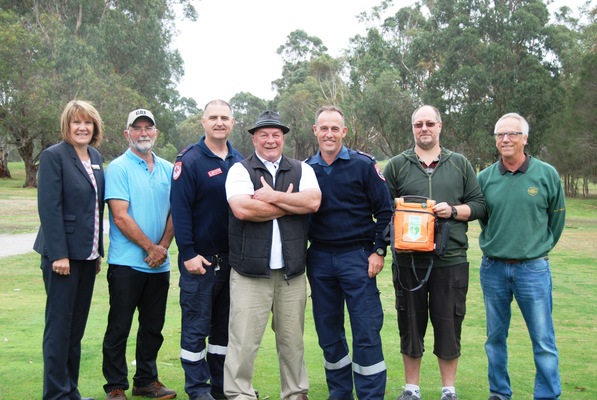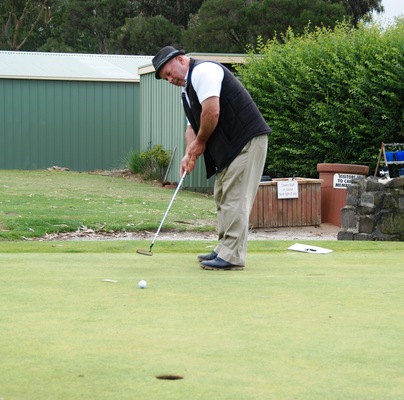
By David Nagel
Imagine having the rare and privileged opportunity to save a loved one’s life.
A family member, a friend, a work colleague, or even a complete stranger struck down with sudden cardiac arrest.
Now imagine the guilt and regret associated with wasting that opportunity and watching a human being perish.
Knowing the location of the nearest automated external defibrillator (AED) means that the chances of saving that loved one, that family member, that friend, that work colleague, that complete stranger improve dramatically.
AEDs are used to treat sudden cardiac arrest, a condition in which the heart suddenly and unexpectedly stops beating.
Paul Miles, his heart stopped beating and he was lucky … no … he was dead lucky!
Paul, 58, and his brother John were about to tee off at the Garfield Golf Club in January, early on a Sunday morning, when Paul collapsed on the first tee.
It was 7.30am when clubhouse manager Kevin Whitmore realised something was horribly wrong.
“I just heard these screams to call an ambulance, there was a bloke down on the first tee and he was having a heart attack so we all had to think pretty quickly,” Mr Whitmore said.
“I rang the ambulance and they told me to stay on the phone while the man’s brother was performing CPR.
“I showed another man where the defibrillator was, he brought that out and wired him up and gave him a zap and he pretty much came back to life.”
Paul Miles had no idea that the Garfield Golf Club was in possession of the AED that would eventually save him from death.
“After my experience, I think it’s very important that we promote knowing the location of these defib machines around the local community,” Paul said from the first tee, where he lost and regained his life.
“I didn’t know there was one here.
“We were lucky that the clubrooms were open and the defib machine was available or I wouldn’t be here today.
“If it happened to me half an hour earlier we wouldn’t have had access to the rooms and it would have been a completely different story.”
Standing behind Paul and John were 20 members of the Cadbury Social Club, Peter Deleu among them. He rushed to the clubhouse and pulled the life-saving machine from the wall.
“We have one (defibrillator) at work and we got introduced to it many years ago,” Mr Deleu said.
“I was a little bit familiar with it, but using it was quite scary at first, but I was the only one who knew about the machine.
“The machine, basically, guided me through the process and gave me a feeling of security. I was in panic, I didn’t know what was happening, but the machine guided me through the process.”
Ambulance Victoria paramedic David Kervin said AV has a register of defibrillator machines but the list was far from complete.
“I’d like to encourage clubs or organisations that have these machines to register with Ambulance Victoria,” Mr Kervin said.
“What happens when triple zero is called is they look at the map and tell you where the nearest registered defib machine is.
“We’ve had quite a few saves where the ambulance has arrived and the patient is still alive because someone has sourced a defib machine from a local business or organisation.
“But, in some cases, staff from those businesses are not even aware that they have one on site. There’s definitely room for improvement.”
The Bunyip and District Community Bank is playing a lead role in making these life-saving machines available.
The bank originally purchased eight defibrillators which were installed in the centre of towns such as Bunyip, Garfield, Maryknoll, Nar Nar Goon and Tynong and been involved in several joint ventures with community groups from around the region.
Branch manager Sue Dubbeld said that purchasing the machines was one thing, but community groups then had the responsibility to share that knowledge.
“If we give a defib to a club it’s important that they actually promote it,” Mrs Dubbeld said.
“It’s everybody’s responsibility to make them accessible to the wider community.
“Sporting clubs are not accessible 24/7, so getting the message across is important that we have 24/7 machines available in the main street of Bunyip or Garfield.
“Promotion is important. Not only does the golf club have one but the bowling club has one as well, the Rec Reserve at Garfield has one.
“Those community groups need to promote that fact.”
Mrs Dubbeld said standing in front of a man who had been revived by a defibrillator made the whole process worthwhile.
“To know that he has actually come out the other side is quite incredible,” she said.
“The whole point of putting the defibs in was, if they get used, great, if not, even better.
“Yes, there’s a cost factor involved, but what’s the cost of saving a life. It’s paid for itself over and over, Paul is living proof.”
Paul said he was handling the whole situation well, but did feel for his family after what he had put them through.
“I was struck by how emotional my loved ones were towards me, compared to me, I didn’t feel emotionally scarred by what I went through,” he said.
“My brother, my wife, my children, my grandchildren, they were just more emotional than I had ever seen them before. And I think that is ongoing.
“I don’t know how John is handling it because if the roles were reversed I would be an emotional wreck every time I saw him.”







